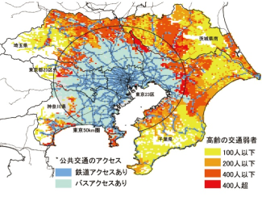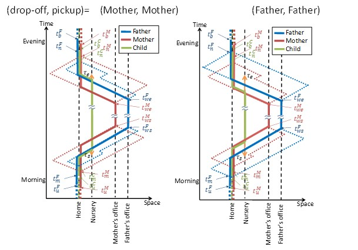- Cities and transportation have a mutual relationship: the demand for transportation changes with the state of the city, and the city changes with the state of transportation. Therefore, to think about better cities and transportation, it is important to consider both aspects of cities and transportation. In addition, since transportation supports various human activities such as studies, work, hospital visits, and leisure, understanding travel behavior also requires analyzing human activities. While there are many research topics in this context, the following are some examples of recent research.
Relationship between urban structure and passenger car CO2

A study that simulates how much CO2 emissions from passenger cars will be reduced by aiming for a compact city in the future.
Estimation of the distribution of the elderly transportation poor

A study simulating where and how many elderly people without access to rail and bus services will occur in the future.
Analysis of people's space-time constraints

A study to create various patterns of daily schedules for households with nursery drop-offs and pick-ups.

Analysis of travel characteristics by district

A study using big data of cell phone location data to analyze differences in travel behavior by district.
Keywords
- Compact city, TOD (Transit oriented development), population distribution, facility layout, land use planning, residential area choice, transportation mode choice, passenger car CO2, population census, economic census, big data, activity-travel analysis, GIS, time geography, statistics, programming, web survey, tourist transportation, work style and transportation, transportation for households raising children, transportation for the elderly





